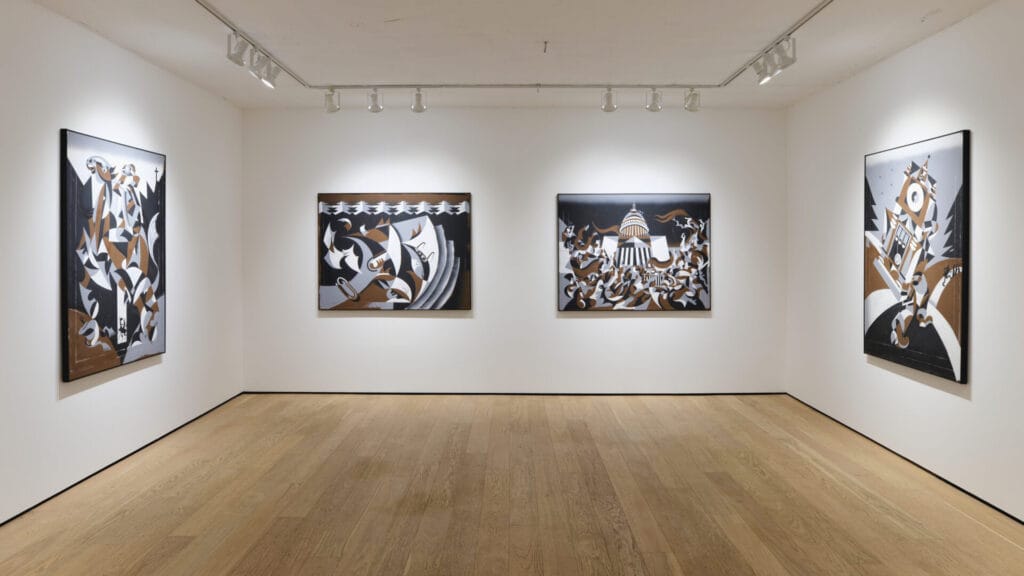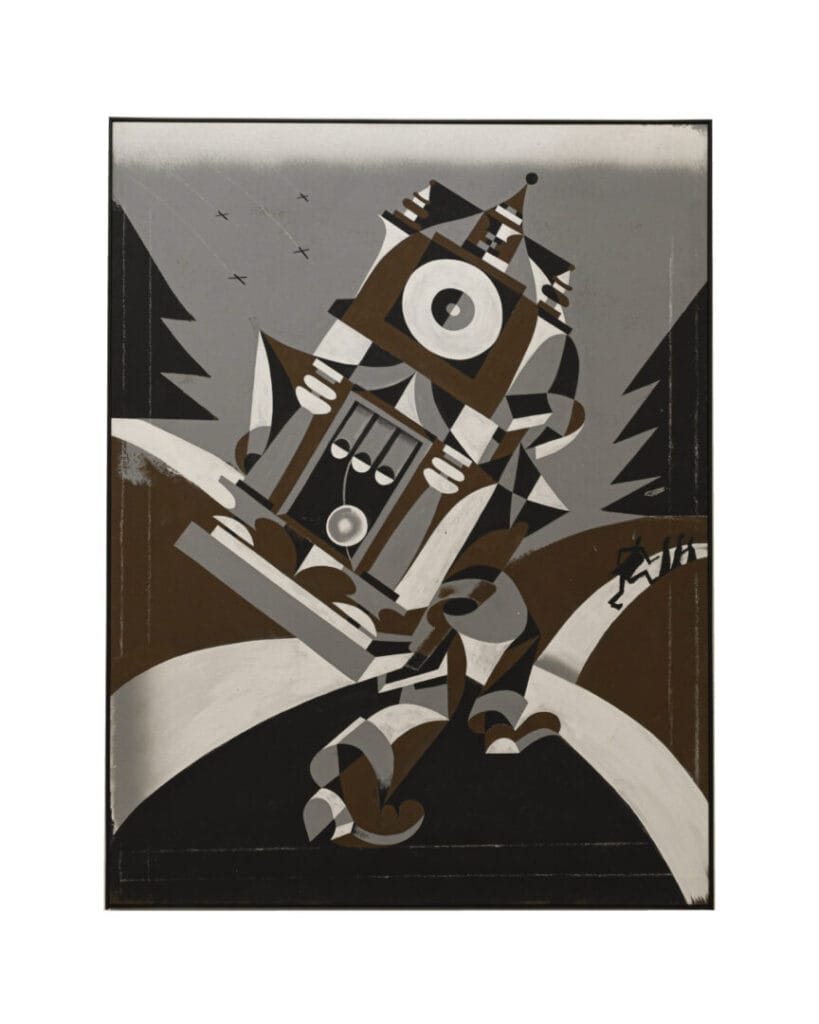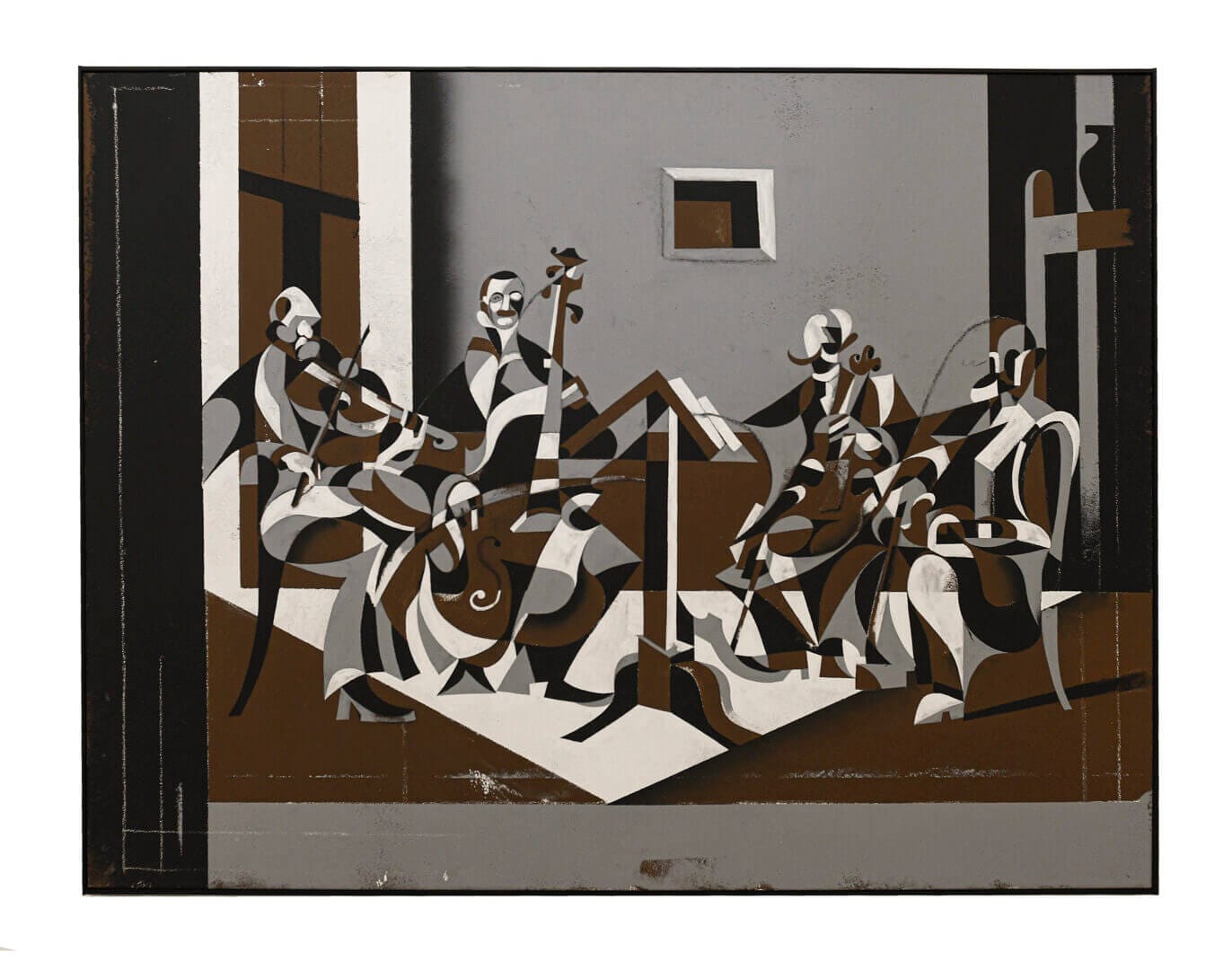Ryan Bock’s “LICH”: A Descent into the Shadowlands of Memory and Myth
When I first stepped into Ki Smith Gallery for the opening of LICH, I immediately sensed that this would not be another ordinary night in the downtown art circuit. The gallery space—known for its avant-garde curation and cerebral atmosphere—had been transfigured into something otherworldly: rhythmic, and charged with an energy that felt both ancient and new. The canvases were not mere pictures hung on white walls—they were thresholds.
Upon entering, I could feel the hum of anticipation ripple through the crowd as the artist, Ryan Bock, quietly moved among us—reserved, and yet unmistakably commanding. His anonymity, at once theatrical and humble, framed the evening like a ritual. In Bock’s world, art is not about self-promotion—it is about revelation.
And so began one of the most intellectually haunting exhibitions I have witnessed in recent years.
Standing within the dimly lit chambers of LICH at the Ki Smith Gallery, I found myself immersed in a visual requiem—an experience that straddled the haunting and the sublime. LICH, the latest solo exhibition from the masked multidisciplinary artist Ryan Bock, is not merely an exhibition; it is a profound confrontation with history’s stubborn refusal to evolve, and a meditation on the seductive power of myth in shaping, dividing, and often destroying human consciousness.
Curated by Celine Cunha, the exhibition draws its name from the town of Lich, Germany, where Bock’s ancestors once lived before their story was irrevocably intertwined with the rise of fascism. This ancestral thread is no mere biographical footnote—it is the emotional and philosophical spine of the work. Created during a three-month residency in Lich, within proximity to one of the Bock family’s historic properties, the artist transforms the burden of legacy into an allegorical language of fractured forms and disquieting symbolism. The result is a series of paintings that merge personal history with collective trauma, bridging the gap between the mythic and the modern.
A Visual Reckoning with History
Across eight monumental canvases and several smaller works, Bock orchestrates a dialogue between epochs—each painting a temporal portal, collapsing time into a single haunting refrain. We encounter an old man fleeing the Holocaust, a Palestinian woman clutching the remnants of her olive tree, and a mob storming the U.S. Capitol—transformed into a mythic Wild Hunt of moral blindness and chaos. These scenes unfold not as discrete historical episodes but as repetitions within a continuum of human folly.

The artist’s visual syntax—angular, sharp, and layered—recalls the aesthetic vocabularies of German Expressionism, Czech Cubism, and Dadaism. His fractured figures and shadowy geometries evoke the disillusionment of an earlier generation of European artists who, after World War I, confronted the collapse of civilization through distortion and abstraction. Bock takes this legacy further, reclaiming and reconfiguring the very visual idioms that the Nazis once derided as “degenerate art.” In doing so, he not only reclaims history but weaponizes its imagery against contemporary authoritarianism.
One cannot discuss LICH without acknowledging Bock’s position within the broader discourse of contemporary art. His practice recalls the moral urgency of postwar artists such as Anselm Kiefer and Gerhard Richter, yet it also carries the performative ethos of Joseph Beuys. Like these predecessors, Bock interrogates not only imagery but ideology—the belief systems that shape how we see.
But where Kiefer monumentalizes trauma, Bock humanizes it. His work feels intimate, even when monumental. It is as though he is less interested in aestheticizing history and more concerned with re-mythologizing it: rebuilding the moral imagination through visual language.
At its essence, and, based on my observations, LICH is an anti-fascist manifesto rendered in paint—a testament to art’s enduring ability to resist, reveal, and resurrect. As curator Celine Cunha observed, “The brilliance of LICH lies in Ryan Bock’s multi-layered narrative architecture—compositionally referencing Expressionism and Cubism to elevate an anti-fascist conversation within the art historical canon, while simultaneously deploying propaganda, folklore, and personal displacement narratives to situate his warning within a transhistorical framework.”
Art as Resistance, Art as Ritual

Grandfather Clock (2024) (photo credit: Andy Zalkin)
Walking through the gallery, I was struck by the near-ritualistic experience of viewing Bock’s paintings. The works seemed to vibrate between anguish and transcendence, as if the act of painting itself were a form of exorcism—a sacred process of confronting inherited shadows.
The exhibition’s title, LICH, also resonates on multiple levels. Beyond its geographical origin, the word echoes “lich”—an undead creature from folklore that refuses to die. This linguistic double entendre encapsulates Bock’s central thesis: history, like myth, cannot be buried. It reanimates itself through generations, reshaping its form while retaining its essence.
“Standing in Lich, I felt a belonging I had never experienced before,” Bock has said. “This body of work is my attempt to confront those repeating cycles—across history, across cultures, and across generations—through the images that bind us.”
The Myth of the Shadow and the Politics of Perception
Perhaps the most poignant allegory threaded through LICH is the tale of Peter Schlemihl, the man who sold his shadow for gold. Bock reinterprets this fable as a parable of modern greed, where identity and morality are commodified in exchange for illusionary power. In his rendering, shadows are not passive reflections but autonomous entities—repositories of suppressed truth.
This motif operates on both personal and political levels. It speaks to the artist’s own confrontation with his lineage, but also to the larger cultural condition of our time, in which narratives are weaponized, and truth is traded for spectacle. Through this visual metaphor, Bock exposes how propaganda—ancient and modern alike—manipulates collective psychology, transforming myth into mechanism.
In one large-scale canvas, a spectral figure appears to dissolve into jagged planes, as though collapsing under the weight of ancestral memory. In another, a masked form—neither saint nor sinner—gestures toward an unseen horizon. The imagery is dense, layered with iconography that feels both familiar and foreign: a broken cross morphs into a shattered sun; faceless figures merge with mythic beasts; propaganda posters disintegrate into prayer-like symbols.
“Ryan Bock’s LICH is a masterful convergence of time, myth, and emotion—an excavation of the human psyche that bridges the medieval and the modern with rare visual eloquence. His work transcends mere aesthetics; it operates as a mirror reflecting both the darkness and divinity within us. Witnessing his art firsthand felt like entering a sacred ritual—a meditation on impermanence, resilience, and creative rebirth.”
— Joseph DeAcetis, Editor at StyleLujo.com and Professor at the Fashion Institute of Technology
In stylistic terms, the artist achieves a remarkable synthesis between aesthetic fragmentation and thematic unity. The paintings’ jagged geometries recall the visual dissonance of early 20th-century modernism, while their chromatic restraint—muted umbers, ashen grays, and visceral reds—suggests both the decaying architecture of memory and the lingering heat of violence.
Legacy, Lineage, and the Long Shadow of Fascism
Bock’s confrontation with his family’s past is neither sentimental nor accusatory. Rather, it is an act of ethical archaeology—a digging through layers of inherited silence to expose the moral architecture of history. By situating himself within a lineage that once thrived in Lich, only to be entangled in the shadows of Nazism, Bock forces the viewer to ask: What does it mean to inherit the debris of ideology? How does one reconcile personal identity with historical responsibility?
In this sense, LICH transcends autobiography. While rooted in the artist’s German-Jewish ancestry, its scope is universal. It becomes a mirror through which all humanity must confront its complicity in systems of division and dehumanization. As the exhibition text notes, LICH “is not a singularly Jewish story. It is a story about humanity—and what is lost when we dehumanize one another.”
The Artist as Cultural Healer
Bock’s practice extends beyond the gallery walls. A co-founder of MOONCALF, an experimental platform for interdisciplinary art and resistance, he merges performance, puppetry, film, and architecture into immersive experiences that expose state violence and challenge cultural apathy. His installations—ranging from haunted houses to living chess sets—are conceived as participatory allegories that collapse the distance between artist and audience, observer and actor.
In LICH, this ethos persists. The exhibition becomes a site of healing, albeit through confrontation. By invoking myths and reanimating historical traumas, Bock proposes that art’s true function is not to soothe but to awaken—to rupture complacency and summon empathy.

In an era where contemporary art continually redefines its own boundaries, I sat down with multidisciplinary artist Ryan Bock to explore LICH—a hauntingly immersive exhibition that blurs the lines between myth, memory, and mortality. In this exclusive StyleLujo.com feature, Bock delves into the symbolic power of art as resistance, the cyclical nature of history, and the thin veil between control and chaos that defines the artist’s creative process. From medieval iconography to modern-day cultural critique, LICH invites viewers into a world where abstraction meets spirituality, decay gives rise to rebirth, and every brushstroke becomes an act of transformation. Through this compelling dialogue, my aim is to reveal how Bock’s work transcends visual expression to become a meditation on identity, time, and the human condition.
Joseph DeAcetis: Your exhibition LICH explores myth, resistance, and transformation. Can you share how the concept of “lich”—a being suspended between life and death—serves as a metaphor in your work?
Ryan Bock LICH:
Ahh, this is actually a misinterpretation of the exhibition title: but one I was hoping I would get an opportunity to address as I am admittedly a fan of this alternative meaning. My exhibition is titled “LICH” after the small German village where I created this body of work—and in turn where my Jewish German ancestors have been traced as far back as the 1700s. The “LICH” you speak of, pronounced differently but spelled the same, refers to a supernatural, undead being of magical capabilities. Something like a necromancer. There is no historical or cultural connection between these two words, however—one of the main themes of this exhibition is the cyclical nature of history, and in particular the return of fascism—thus the concept of an undead wizard actually fits very well as a double entendre. We live, we die, we live again through magical means. Even making physical art could be seen as an attempt to live after one’s own death.
Joseph DeAcetis: The visual language in LICH is strikingly layered. How do you approach the interplay between abstraction and figuration in conveying psychological or spiritual states?
Ryan Bock LICH:
For me this is a very important line to straddle in painting as a personal preference. As someone who could draw photo-realistically from a very early age—my interest in painting realism is basically zero. For me the beauty of painting is the chance of creating something that cannot exist in physical space or reality as we perceive it while still giving just enough visual information to tether the viewer’s recognition. For me the intention of painting is to transport the viewer—to reframe their perspective beyond the visual experience. The psychological intent behind this varies from piece to piece/project to project. But my particular form of abstracted representation can tether all of these concepts together into one cohesive world of my creation.
Joseph DeAcetis: Your use of materials often feels ritualistic. What role does materiality play in shaping the narrative or emotional resonance of your pieces in this show?
Ryan Bock LICH:
For me—creating physical art is already ritualistic by nature. We’re talking about communication via mark-making that predates written language. I think about cave paintings, and the power that comes with being able to visually identify and in turn name and categorize the wild things in the world around us through representational painting. Categorization is an inherently human attribute that I see as both one of our greatest strengths and also one of our most terrible weaknesses. Language in both verbal and written form is magic. Hence our word for “spelling”—as ‘in’ or ‘under’ a “spell.” Image-making is far more primordial and pure. For all of my projects I ensure a measured outcome by controlling my environment via visual and sonic input in order to create a particular mind state while creating. I have to get there myself before I can take someone else. I think it’s less about the materials and more about the trance one finds oneself in during the process of creation, or viewing and learning to intentionally control that while calling on the ancient practice of painting. This body of work was an extreme undertaking and experiment in that regard. And I’m very happy with the results.

January 6th, 2021 – The Wild Hunt– (2024) (photo credit: Andy Zalkin)
Joseph DeAcetis: The exhibition title evokes both fantasy and folklore. How do you see myth functioning in contemporary art—as escape, critique, or perhaps prophecy?-
Ryan Bock LICH:
I think folklore and mythology are tools. For me the first question is not how these tools function but WHO is wielding them. And then we can guess at the intent behind the usage. Tools can build a house but also have the capability of tearing it down. For me personally—I want to use these stories to dispel falsehood and bring truth to light. There are prophetic aspects to the work that I do—but I can boil this down to excellent pattern recognition skills and being generally in tune with history and current events. For me escapism becomes more entertainment than art. A distraction. But this might be a hot take—and certainly not mutually exclusive. I can only guess at the intent of the Artworld at large—which I can only claim partial relation to as an artist who largely exists as an outsider to the general institutions of art.
Joseph DeAcetis: LICH seems to challenge the viewer’s perception of time and decay. How do you think your work engages with the idea of impermanence or entropy?
Ryan Bock LICH:
I think it was Heraclitus who said, “No man ever steps in the same river twice, for it’s not the same river and he’s not the same man.” As someone who spends most of their time and energy creating physical objects, impermanence is in many ways something I rage against. But really, I just try to enjoy things in the moment while they last. Despite its dark implications, I do believe LICH to be a celebration of the past and an acceptance of what has transpired—while simultaneously recognizing the echoes that still very much affect the world today.
Joseph DeAcetis: There’s a palpable tension between control and chaos in your compositions. How do you navigate that duality in your creative process?
Ryan Bock LICH:
Man, for me control is easy in painting. It’s letting go and accepting the chaos that’s hard. So much of the physical exercise of LICH was letting go for me. Historically, my work has been so tight, so mechanical. I went as far as I could go in this extremely graphic temperance of painting with my last I’m not funded by the CIA series, so challenging myself to let things lie as they fell for this series was hugely important to me. It was actually a very large divergence—leaving some of the underdrawing visible, letting the paint be paint, being more actively present while painting and revealing my “hand” more in these works than I had previously. The world is in chaos and these works needed to represent that.
Joseph DeAcetis: Your aesthetic often references medieval and occult iconography. What draws you to these visual traditions, and how do you reinterpret them for a modern audience?
Ryan Bock LICH:
The town of Lich is a perfectly preserved testimony to medieval architecture and being surrounded by this was paramount in the creation of this series. Again, I do believe art-making to be intrinsically occult in nature, but I do obviously have a strong attraction to this branch of study. I believe there is a long and sordid tradition of reading and utilizing visual information that is lost on the general public today by design. We are trained to look but not to “see.” I hope through small reveals of my own study and practice to reintroduce these traditions to contemporary audiences in order to help individuals understand the world around them better—to recognize symbols and hidden language that is very much still prevalent today, as one of many examples I could give, in advertising and marketing. So much of my work comes from a deep appreciation for iconography, which is misunderstood in our modern age as it has moved almost entirely into the subconscious of the viewer as opposed to the forefront of communication.

Mahfoza Oude, 2005 (photo credit: Andy Zalkin)
Joseph DeAcetis: In LICH, resistance is a recurring theme. Do you see your work as a form of cultural or existential resistance—and if so, against what forces?
Ryan Bock LICH:
In short, yes absolutely to both. Even the way I move through life I consider active resistance. I wear a mask while others take selfies. An exhibition is a public statement—it’s political by nature. In our current climate, something as simple as provoking open discourse or encouraging critical thinking is resistance—and increasingly so. The true value of art has never been monetary, though that’s what many would have us believe. Art has the power to shape society for better or worse. Authoritarian governments in their greed and corruption—they all know and fully understand the true psychological power of art and design. As we continue to watch massive, concerted efforts to censor culture, manipulate history, and fray the truth—a truly independent and free artist must meet these forces on the battleground of soft power with free and pointed expression. We cannot allow our American-bred complacency to spread so widely via empty Hollywood films and formulaic music. Culture needs real substance to generate a healthy, proactive, and sympathetic society.
Joseph DeAcetis: The exhibition feels immersive, almost theatrical. How do you think spatial arrangement and curation shape the viewer’s psychological journey through the show?
Ryan Bock LICH:
For this particular exhibition I think the order of appearance is very important while reading and understanding the series. We explore fairy tales and myth and then in quick succession we are confronted with real, historical truth perhaps once framed as “conspiracy theory.” This juxtaposition serves as the basis for the questions I hope LICH evokes. Why do we continue to allow our stories to be weaponized and why do we continue to ‘other’ and brutalize our neighbors?
Joseph DeAcetis: As an artist working in New York, how does the city’s energy, history, or mythology inform your practice—especially in the context of LICH?
Ryan Bock LICH:
Due to the diverse nature of the city, I think it lends itself perfectly as a backdrop for telling stories that can be both personal and universal simultaneously. Though admittedly I did not make this series here, and often escape the city to try and fabricate long, uninterrupted periods of deep focus, I absolutely adore New York City and I think it’s one of the most inspiring and exciting places to make and exhibit art—that is, if you can stay focused and strike a balance between work and play.
A Personal Reflection:
As I stood before the final canvas—a distorted tableau where past and present collided in an almost cinematic crescendo—I was reminded of Walter Benjamin’s Angel of History, blown backward through time by the storm of progress. Bock’s figures, too, are caught in that perpetual gale: neither moving forward nor retreating, but suspended in the tension between remembrance and renewal.
What I witnessed at the opening of LICH was more than an exhibition—it was a collective reckoning. Viewers were visibly moved, exchanging hushed reflections in the dim light, as if aware they were participating in a ritual of remembrance. In a time of resurgent nationalism and social fragmentation, Bock’s art feels both prophetic and necessary.
It reclaims the moral function of art as a cultural conscience, reminding us that myth is not an escape from reality but its most revealing reflection.
Leaving the gallery that night, I carried with me not despair but clarity. Bock’s work insists that confronting darkness is not the same as surrendering to it. In a time when images are too often stripped of moral gravity, LICH restores their sanctity.
Save Article








